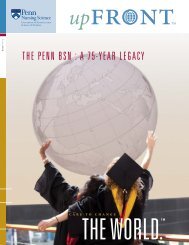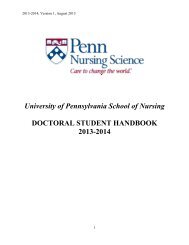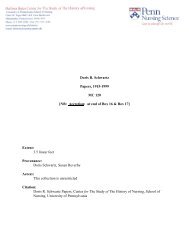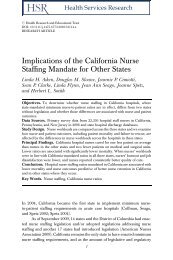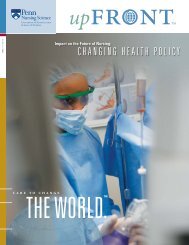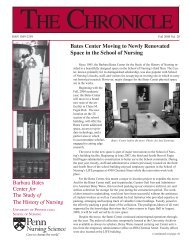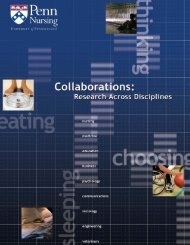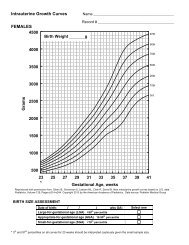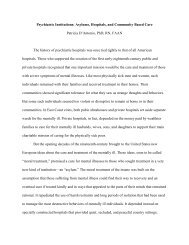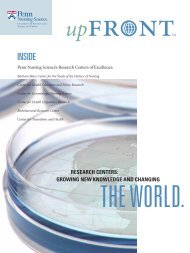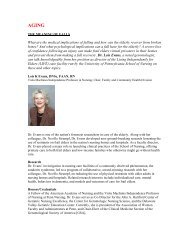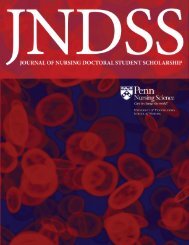upFRONT spring 07.FINAL.rev - University of Pennsylvania School ...
upFRONT spring 07.FINAL.rev - University of Pennsylvania School ...
upFRONT spring 07.FINAL.rev - University of Pennsylvania School ...
You also want an ePaper? Increase the reach of your titles
YUMPU automatically turns print PDFs into web optimized ePapers that Google loves.
faculty care to change the world<br />
searching for a breakthrough:<br />
The <strong>Pennsylvania</strong> Center for Autism and Developmental<br />
Disabilities Research and Epidemiology<br />
Will Foley, shown here with his mother, Rosemary,<br />
was diagnosed with PDD-NOS- pervasive<br />
developmental disorder, not otherwise specified.<br />
Through early diagnosis, occupational and<br />
speech/language therapy at the Regional Autism<br />
Center <strong>of</strong> The Children’s Hospital <strong>of</strong> Philadelphia,<br />
Will has surmounted tremendous developmental<br />
obstacles just to perform everyday activities.<br />
Autism and autism spectrum disorders<br />
(ASDs) do not discriminate. These<br />
developmental disorders – defined by<br />
substantial impairments in social interaction<br />
and communication and the presence <strong>of</strong><br />
unusual behaviors and interests – affect all<br />
racial, ethnic, and socioeconomic groups.<br />
Symptoms <strong>of</strong> autism – which include loss or<br />
lack <strong>of</strong> speech, little or no eye contact, lack<br />
<strong>of</strong> social interaction with family members or<br />
peers, diminished use <strong>of</strong> gestures, and<br />
repetitive or unusual behaviors – may be<br />
visible shortly after birth or by the time a<br />
child turns three years old. Symptoms <strong>of</strong> ASD<br />
span a lifetime.<br />
There is much to be known about autism,<br />
despite its rising p<strong>rev</strong>alence, including the<br />
vital question <strong>of</strong> how many children are<br />
affected. The reason for the rise is itself a<br />
controversial topic: is it due to improved<br />
detection or does it actually represent a real<br />
increase in the incidence <strong>of</strong> the disorder? The<br />
<strong>School</strong> <strong>of</strong> Nursing and The Children’s Hospital<br />
<strong>of</strong> Philadelphia (CHOP), are collaborating in<br />
the <strong>Pennsylvania</strong> Center for Autism and<br />
Developmental Disabilities Research and<br />
Epidemiology (PA-CADDRE), funded through<br />
the national Centers for Disease Control and<br />
P<strong>rev</strong>ention (CDC) to study ASDs. The Center is<br />
part <strong>of</strong> a network <strong>of</strong> six centers that measures<br />
the p<strong>rev</strong>alence <strong>of</strong> this developmental disorder<br />
in defined geographic regions across the<br />
country. In addition, the Centers are engaged<br />
in research to find genetic markers and<br />
possible environmental triggers.<br />
The CDC estimate 500,000 Americans from<br />
birth to 21 have ASDs and that approximately<br />
one in 150 children have an ASD. The<br />
number <strong>of</strong> children ages 6-21 years receiving<br />
services for autism increased from 22,664 in<br />
1994 to 193,637 in 2005.<br />
“The data that we are collecting in the<br />
surveillance studies can potentially help states<br />
prepare for increases in the number <strong>of</strong><br />
children with ASDs who are entering their<br />
school systems,” says Center Director Jennifer<br />
A. Pinto-Martin, HOM ’98, PhD, MPH, the<br />
Viola MacInnes Independence Pr<strong>of</strong>essor <strong>of</strong><br />
Nursing. “<strong>School</strong>s will know what type <strong>of</strong><br />
special support services they will need to <strong>of</strong>fer<br />
these children and their families.”<br />
“It is reassuring that, when there is so much<br />
that is unknown about autism, there are<br />
researchers who share the urgency <strong>of</strong><br />
parents <strong>of</strong> autistic children and are asking<br />
the right questions to find out what causes<br />
ASDs,” says Erin Lopes, the mother <strong>of</strong> a<br />
seven year-old son with autism and a<br />
member <strong>of</strong> the Center’s advisory board. “The<br />
dedication <strong>of</strong> the PA-CADDRE staff is<br />
admirable. Their commitment to this research<br />
demonstrates that ‘We’re all in this<br />
together.’”<br />
PA-CADDRE is the only Center in<br />
<strong>Pennsylvania</strong> established by the CDC in 2001<br />
as a result <strong>of</strong> a mandate in the Children’s<br />
Healthcare Act 2000. The other CADDRE<br />
centers are located at the California<br />
Department <strong>of</strong> Health; Colorado Department<br />
<strong>of</strong> Public Health and Environment; National<br />
Center for Birth Defects and Developmental<br />
Disabilities <strong>of</strong> the CDC in Atlanta; Johns<br />
Hopkins <strong>University</strong>; and the <strong>University</strong> <strong>of</strong><br />
North Carolina at Chapel Hill <strong>School</strong> <strong>of</strong> Public<br />
Health. Joining Dr. Pinto-Martin in the<br />
PA-CADDRE work are Research Associate<br />
Pr<strong>of</strong>essor <strong>of</strong> Nursing Ellen Giarelli, GNC ’98,<br />
GR ’02, CGS ’05, EdD, CRNP, CS, and Clinical<br />
Pr<strong>of</strong>essor <strong>of</strong> Pediatrics and Medical Director<br />
<strong>of</strong> the Regional Autism Center <strong>of</strong> CHOP<br />
Susan E. Levy, CW ’69, RES ’75, MD.<br />
(continued)<br />
22



